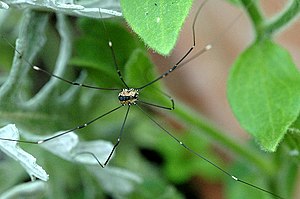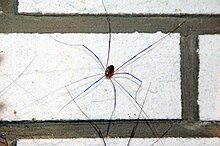Leiobunum
| Leiobunum | ||||||||||||
|---|---|---|---|---|---|---|---|---|---|---|---|---|

Leiobunum rotundum (female) |
||||||||||||
| Systematics | ||||||||||||
|
||||||||||||
| Scientific name | ||||||||||||
| Leiobunum | ||||||||||||
| CL Koch , 1839 |
Leiobunum is a genus from the Sclerosomatidae familyin the order of the harvestmen .
features
Like most harvesters, the species of the genus have a compact physique. The coloration varies from species to species, the males are often clearly differently colored than the females.
The body is completely soft or almost leathery only on the back. The eye mound is approximately as wide and long as it is high, often with small bumps above each eye. The front edge of the carapace is free of humps in the middle, the surface of the back is largely unreinforced. The first five tergites in males are often fused together to form a solid dorsal shield .
Teeth are often formed on the coxes , but sometimes only on those of the first and last pair of legs. The first of the cheliceric links is smooth on the back. On the middle phalanx of the palpus there are no apophyses towards the tip or in the middle , but occasionally there is slight swelling. The tarsi of male animals are covered in the center with a longitudinal row of small tubercles on the underside . Leiobunum has only one tagged tarsal claw on each leg .
The legs of most species are strikingly long, with spans of over six inches. The femur of the first pair of legs is usually significantly longer than the body. The second pair of legs is always the longest and significantly longer than the fourth pair of legs.
behavior
Of some species of the genus leiobunum are aggregations known of several hundred animals.
Occurrence
The species described so far come from Asia, Europe, North Africa and North and Central America.
Systematics
The genus was first described in 1839 by Carl Ludwig Koch in his overview of the arachnid system , the name (λεῖος = smooth, βουνος = hill) refers to the smooth seam above the eye hill. The type species is Leiobunum rotundum , which was described as Phalangium rotundum by Pierre André Latreille as early as 1798 .
The exact extent of the genus is unclear; over 100 species , often synonymous , have been described . Partial revisions exist for Europe, Japan and North America.
Synonyms
The following synonyms are known from the literature for the genus Leiobunum :
- Forbesium Weed, 1890
- Leiobunus Meade, 1855
- Liobunum Agassiz, 1846
- Metaliobunum Suzuki, 1940
- Pseudoliobunum Müller, 1914
European species
The following species are represented in Europe:
- Leiobunum biseriatum ( Roewer , 1910)
- Leiobunum blackwalli ( Meade , 1861)
- Leiobunum ghigii ( Caporiacco , 1929)
- Leiobunum limbatum ( L. Koch , 1861)
- Leiobunum lusitanicum ( Roewer , 1923)
- Leiobunum nigripalpe ( Simon , 1879)
- Leiobunum religiosum ( Simon , 1879)
- Leiobunum roseum ( CL Koch , 1839)
- Leiobunum rotundum ( Latreille , 1798)
- Leiobunum rumelicum ( Shilhavý , 1965)
- Leiobunum rupestre ( autumn , 1799)
- Leiobunum seriatum ( Simon , 1878)
- Subalpiner Schwarzrückenkanker Leiobunum subalpinum , ( Komposch , 1998) - (Eastern Alps)
- Leiobunum tisciae ( Avram , 1968)
Neozoon
Another, so far unspecified, probably entrained leiobunum -Art of unknown origin has been established in recent years in the Netherlands (as probably the first European country where it occurred), Austria, Switzerland and Germany. It often occurs in buildings in aggregations of several hundred individuals.
Individual evidence
- ↑ a b c J. Martens: Arachnids, Arachnida: Weberknechte, Opiliones. Die Tierwelt Deutschlands, Vol. 64. Gustav Fischer Verlag, Jena 1978
- ↑ a b c N.W. Davis: A revision of the genus Leiobunum (Opiliones) of the United States. Amer. Midland Nat., 15 (6): 662-705.
- ↑ James J. Cockerill: Notes on Aggregations of Leiobunum (Opiliones) in the Southern USA In: Journal of Arachnology, Vol. 16, No. 1, 1988, pp. 123-126
- ↑ CE Prieto and J. Fernandez: El género Leiobunum CL Koch, 1839 (Opiliones: Eupnoi: Sclerosomatidae) en el Peninsula Ibérica y el Norte de África con la descrptión de tres nuevas especies. Rev. Ibér. Aracnol., 14 pp. 136-171, 2007
- ↑ ALM Tourinho: Sclerosomatidae page no longer available , search in web archives: Species Listing Version 2007
- ^ Carl Ludwig Koch: Overview of the arachnid system , Vol. 2, Verlag CH Zeh, 1839, p. 35
- ^ Joel Hallan's Biology Catalog: Page no longer available , search in web archives: Sclerosomatidae
- ^ S. Suzuki: The genus Leiobunum CL Koch of Japan and adjacent countries (Leiobunidae, Opiliones, Arachnida). J. Sci. Hiroshima Univ. B1 (Zoology) 26, pp. 187-260, 1976
- ^ SC Bishop: The Phalangida (Opiliones) of New York, with special reference to the species of the Edmund Niles Huyck Preserve, Rensselaerville, New York. Proceedings of the Rochester Academy of Science, 9, pp. 159-235, 1949
- ^ Checklist of valid genera of Opiliones of the World. Adriano B. Kury, accessed November 7, 2009 .
- ^ Leiobunum CL Koch 1839. Fauna Europaea, Version 1.3, April 19, 2007 , accessed on November 6, 2009 .
- ↑ Page no longer available , search in web archives: Animal endemics in the Gesäuse National Park (PDF file; 1.25 MB) at www.np-gesaeuse.at (accessed on November 8, 2009)
- ↑ Hay Wijnhoven et al .: An unidentified harvestman Leiobunum sp. alarmingly invading Europe (Arachnida: Opiliones) . (PDF file; 1.81 MB) Arachnologische Mitteilungen, 34, pp. 27–38, 2007
Web links
- Leiobunum at Fauna Europaea. Retrieved August 14, 2011

